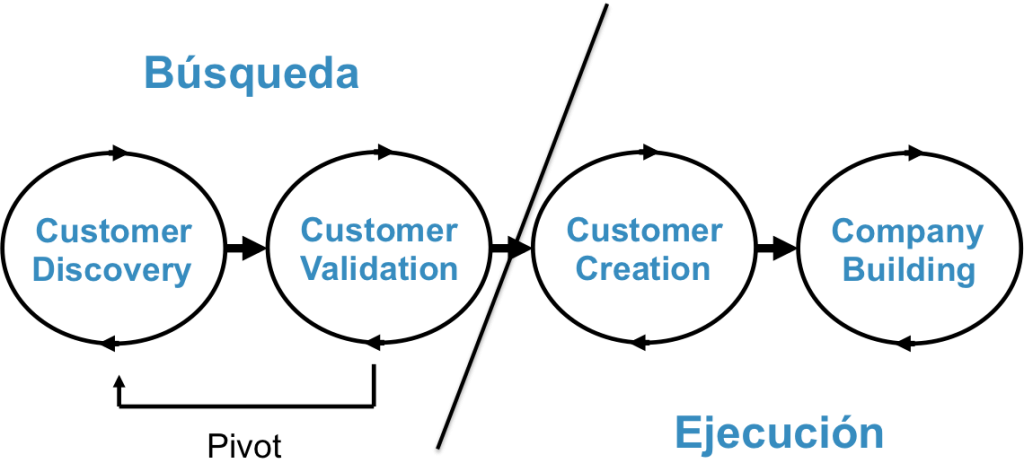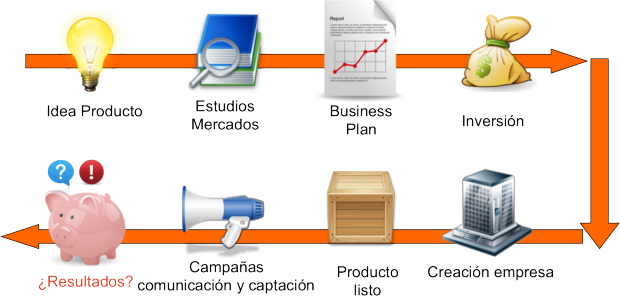Many entrepreneurs often face an abyss the day they have their project business model, defined and must start making it come true. Where do I start from? What do I do now?
Traditional business start-up style
What we’ve been taught until now is what we call the traditional enterprises creation style. It goes like this:
Somebody has an idea for a product; something he thinks can work in the market (and make us rich). According to traditional teachings, the first thing you have to do to convince anybody about your idea is to write “The Business Plan” so he starts making very intense market research and writes the business plan, that includes:
- Detailed macroeconomic analysis
- Microeconomic analysis
- Sectorial research and competition research
- S.W.O.T. analysis
- Strategic plan: mission and vision
- Technical research
- Legal research
- Marketing plan
- Human resources plan
- Financial plan: investment plan, finance plan, a 5 year operating profit, investment analysis (payback, N.P.V., I.R.R., and sensitivity analysis) and in the last place, a 5 year balance sheet.
And, all this, based on a product IDEA… But let’s go on, after studying the market and writing the business plan, the entrepreneurs go searching for the investment. After getting it, they begin to execute that plan they designed and that is the one that convinced the investor. They start with the enterprise creation, hiring all the personnel, detailed in the human resources plan and product creation. Once they have that product they once envisioned and that is perfect for them, they start launching communication campaigns and customers acquisition. That’s the moment when, according to the plan, clients should begin arriving and we should start earning money…money we have spent and need to recover (!).
Statistics say that 9 of every 10 startups fail. And, why? Because money doesn’t come in, because the wonderful income plan we designed is not being achieved, and however, expenses keep coming punctually like a clock…(horror!)
And why isn’t money coming in? Well,
the main cause of startups failure is that they create a product nobody wants. They fail because of lack of clients.
New methodologies: Customer development process
There are new methodologies of startups creation that differ from the traditional enterprises creation style and that are closely aligned to Eric Ries’ Lean Startup concept: “Fail fast, fail cheap”
The customer development process, created by Steven G. Blank as a guide for startups creation, is nothing else but the testing process of the business model, given that your project’s business model is no more than a group of hypothesis to validate.

The customer development process divides the startup creation in two big stages: the business model search and the business model execution. During the first stage the startup validates all the business model hypothesis defined in the first place and makes changes when it considers it necessary (“pivots” its business model). After demonstrating it has a business model that can be repeated, profitable and that can be made by scale, it will go to the next stage, the execution of said model, investing then in attracting clients in a continuous way and building the company.
Each one of these stages is divided in two steps. In very general terms, the “Client discovery”, the first step, is focused on understanding the client’s problems and needs leaving the office and asking them directly. The “Client validation” is focused on developing a sales model that can be copied. In this step, a simple beta phase of the product allows us to get feedback from the first clients.
The “Client creation”, already in the stage of model execution, is focused on creating and directing in a continuous way the demand to our sales channels (through different marketing campaigns) and, in the last place, the “Company creation” consists in making the transition from an organization focused in learning and discovering to one focused in the business execution (previously found). It is in this last step when you start hiring personnel and creating departments.
An important item of this process is that it keeps the startups in a low money consumption mode (investment) until the business model is validated by finding clients that pay. This item marks the transition between the two big stages in which the clients development process is divided (search and execution) as well as the difference to obtain a higher number of startups able to carry out their project successfully.
